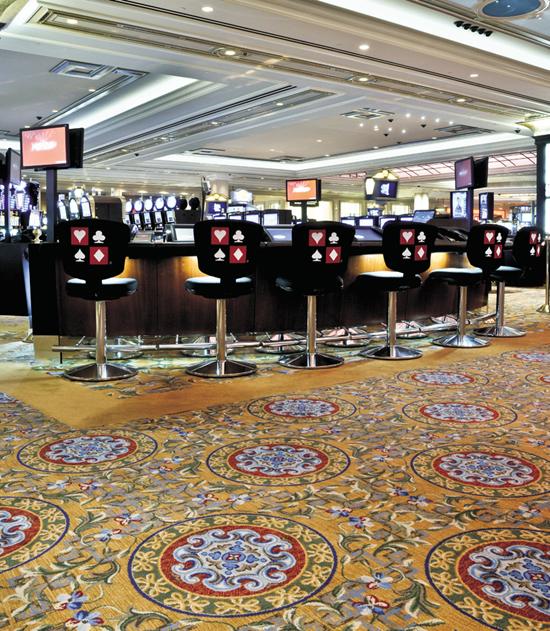Casino Carpet - February 2010
By Brian Hamilton
Casino carpet is a niche in the hospitality industry that’s unlike any other commercial segment because of its combination of styling, construction and what some might call its subliminal messages. It’s hard to get a fix on how much casino carpet is sold annually in the U.S. However, a small casino job would be about 10,000 square yards.
The casino industry, especially in Las Vegas, has been mired in a slump for more than a year, so there has been far less renovation and construction than usual. Hotels aren’t commanding the rates they were a couple of years ago. “We went through a phase when casinos were being renovated on a regular basis but now we’re seeing longer replacement cycles,” said John Louw of
Ulster Carpets, one of the major casino carpet manufacturers.
Virtually all casino carpet is custom designed, and carpet in Las Vegas is generally higher end than carpet at other gambling establishments across the country. “Vegas is a very demanding market,” said David Cluer of Brintons. “They sometimes want something in a ridiculous time frame.”
The vast majority of carpet used in the gaming areas themselves—about 90%—is a woven blend of 80% wool and 20% nylon, and most of that is broadloom, although tile is occasionally used for easier access to underfloor electronics. It tends to be the highest quality carpet in the casino complex. The wool keeps the carpet from burning if a cigarette is dropped. It all has to be anti-static because of the gaming equipment. Nearly all of this carpet is manufactured overseas and can run anywhere from $30 to $50 per yard, although for the extreme high end establishment, hand-tufted carpet might run $300 per yard.
The ballrooms are also largely the 80-20 blend, but the guest rooms themselves are often durable 100% solution dyed tufted nylon. Brintons also likes to use a 3’ square Axminster tile in places like the ballrooms, and sometimes in the gaming areas.
Under normal circumstances, casino carpet is replaced every three to five years, generally quicker than a typical hotel, but not usually because the carpet wears out. The casino business is extremely competitive, and the high end casinos like to keep their establishments fresh looking. However, Louw has seen some Ulster carpet down as long as ten years. “Something that’s not commonly understood is that not all wool is the same. The quality is markedly different,” Louw says.
Of course, what’s most distinctive about casino carpet is its design, which is unlike anything else in the commercial sector. Papers have been written on the ways carpet design can get visitors to gamble more (perhaps by focusing attention on the slot machines), and whether designs with curves are more inviting to gamblers than designs with more angular shapes, but it’s something that’s difficult to prove. Do rainbows in carpet somehow make gamblers feel lucky or at least more optimistic?
“The design just sends a message that ‘this isn’t home,’” said David Schwartz, director off the Center for Gaming Research at the University of Nevada Las Vegas. “With carpet, they’re just trying to create a festive atmosphere.”
Schwartz, who has dozens of photos of casino carpet on his website, dieiscast.com, said recent design trends are using more earth tones and fewer pastels. “The florals are still there, but there are more geometric patterns.” His website notes that many casinos have used designs incorporating floral patterns or wheels. “In a strange way, though, it’s a sublime work of art, rivaling any expressionist canvas of the past century,” he wrote.
Casino carpet is often designed by independent design firms that specialize in the niche, and sometimes by the mills, and the design is a huge focal point of the overall casino design.
The designs tend to be very intricate and they’re often theme oriented, carrying the general theme from the casino floor into the ballrooms and bedrooms. They also have to span huge spaces. It’s not unheard of for a casino pattern to have repeats of 90’ or more, which can make manufacturing a challenge. Part of the reason the patterns are so busy is they hide wear and soiling more efficiently.
Cluer of Brintons said for the new City Center project his firm was asked to create designs that would have the look of land while flying over it.
Tai Ping also does a brisk casino business. It has design studios on all continents, and its designers generally use computers to create their designs. “Casinos are the ideal location to go wild and do creative designs,” says Elliott Steel, global design manager for Tai Ping’s commercial division. “I don’t think it does anything to affect the gaming but it is part of the ambience.”
Steel has also seen more sophisticated designs emerge in recent years. “The movement is more toward sophisticated colors, and the neon bright colors are dissipating,” he said. “The expectation for design is very high.” He said that while the scale of the design tends to be larger than for other carpets, that’s beginning to change.
Designs for guest room carpet have also gotten a lot more fun in recent years and often feature borders and insets, said Randall Thorne of Signature Hospitality Carpets.
Copyright 2010 Floor Focus
